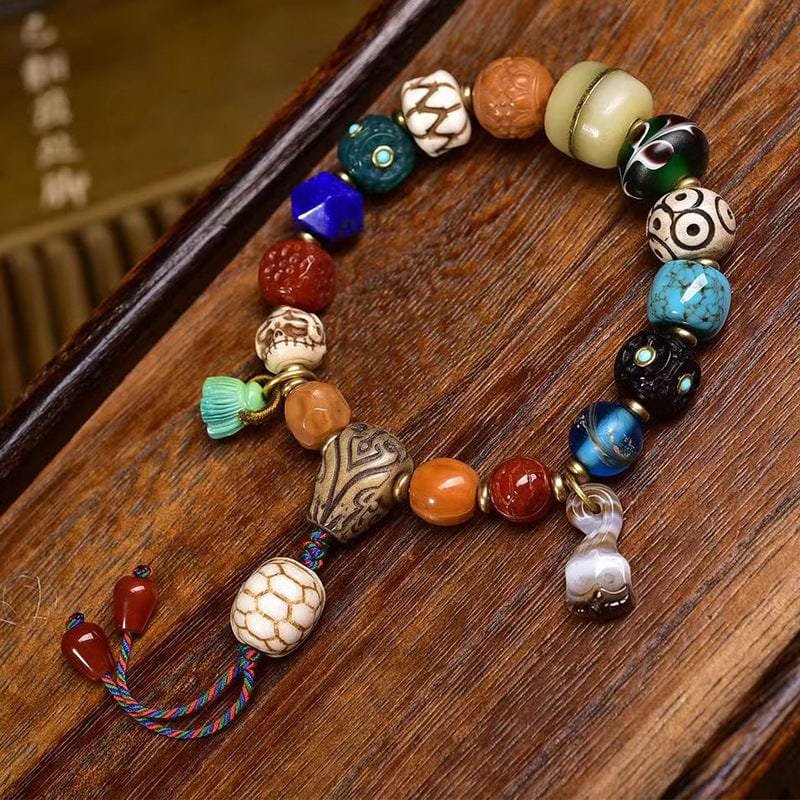Tibetan Beaded bracelet: the intersection of culture and destiny
In Tibetan cultural traditions, “Lianzhu” (string of pearls) transcends mere bead arrangement —— It embodies the dialogue between snow-capped mountains and sacred lakes, bridges ancestral wisdom with modern life, and converges individual destinies with ancient heritage. Tibetan artisan Laba often remarks: “A fine Lianzhu bracelet connects beads to the roots of Tibetan civilization and the wearer’s destiny.” When his hands interlace these culturally imbued pearls, the bracelet becomes a “living vessel”: carrying millennia-old Tibetan cultural legacy while weaving together the wearer’s unique life journey.
Laba's persistence: Let the beads "string together" Tibetan culture
In the historic district of Shigatse, Lhaba’s workshop displays a Tibetan Bead Ornament Atlas passed down from his grandfather. The yellowed pages meticulously document cultural symbolism behind various bead arrangements. “Each bead and every threading method in a prayer bracelet carries profound meaning,” Lhaba explains, gesturing toward the “Nine-Bead Chain” design. “Tibetans believe nine symbolizes auspiciousness – corresponding to the nine sacred peaks of the snow mountains. When nine beads are strung together, it’s as if wearing the guardian power of the mountains on your wrist.”
When crafting prayer bead bracelets, the master craftsman prioritizes “integrating cultural symbolism.” His selection process emphasizes Tibetan heritage elements: silver beads engraved with the “Six-Syllable Mantra” symbolize spiritual purification in Tibetan Buddhism; Tianhe Stone (Tibetan River Stone) featuring natural water patterns mirrors sacred lakes in Tibet, representing the cleansing of worldly troubles; while vajra rods crafted from ancient Tibetan silver embody the power to overcome adversity. These elements are not arbitrary additions but embody the cultural codes —— learned from his grandfather’s teachings: “A single symbolic bead missing means a piece of Tibetan soul is missing from the bracelet.”
Last year, a scholar specializing in Tibetan culture approached Lhaba to create a prayer bead bracelet that “reflects the four seasons of Tibet.” Lhaba selected four main beads: turquoise for spring (symbolizing grassland revival), red coral for summer (representing plateau sunshine), amber for autumn (corresponding to golden harvest), and white agate for winter (mirroring snow mountain purity). These were strung together with silver beads engraved with seasonal patterns. After receiving the bracelet, the scholar wrote back: “Wearing this necklace while conducting field research, touching each bead feels like experiencing all four seasons of Tibet. This is the most vibrant form of cultural inheritance.”
For Lhaba, the bead-tying ritual embodies a cultural replication. Instead of using mechanical fasteners, he employs the Tibetan “marwa knot” to interlock beads —— This intricate binding symbolizes “cultural continuity that never breaks.” After tying three beads together, he wraps a red cotton thread around the knot . The color red, considered an auspicious hue in Tibetan culture, represents “binding good fortune between heritage and destiny.”
The fate code of the beads: each one is waiting for "the right person"
Laba firmly believes Tibetan prayer beads carry a spiritual “devotion to the Lord” ——, which manifest different “resonances” according to the wearer’s destiny. In his workshop, there once existed a prayer bead bracelet crafted from aged agate and copper beads that remained unclaimed for six months. It wasn’t until a young man named A Zhe arrived, recounting his entrepreneurial failure and stating he “wanted something to help him ‘get through’ this tough time”.
Laba picked up the bracelet: “The old agate was passed down through generations, weathered by time. The copper beads I melted from Tibetan antique copperware-they’re durable and crafted with precision —— They’re meant for those who must ‘weather adversity’.” After Ah Zhe put it on, he would constantly rotate the agate beads whenever facing challenges, “Turning them keeps me grounded.” When Ah Zhe’s career took off, he specially brought a khata to thank Laba: “This bracelet seems to know my destiny. It stayed with me through all hardships.”
Such “destiny convergence” scenes are commonplace in Raba’s workshop. When a couple came to order a matching bracelet, Raba crafted a “complementary pair”: the woman’s bracelet featured pink coral (symbolizing gentleness) paired with silver bells, while the man’s incorporated black agate (representing protection) with small copper bells. “Though the two bells sound different, their harmony together mirrors your destiny – each unique yet perfectly aligned,” he explained. The couple later exchanged photos of their wedding day bracelets, declaring, “The bracelets have woven our life’s journey.”
“The beauty of a chain bracelet is that it is not ‘one-way giving’, but ‘two-way selection’ —— Culture gives it soul, fate makes it find its owner, and when the two meet, it is the best intersection,” says Raba.
For Lhaba, the bead-tying ritual embodies a cultural replication. Instead of using mechanical fasteners, he employs the Tibetan “marwa knot” to interlock beads —— This intricate binding symbolizes “cultural continuity that never breaks.” After tying three beads together, he wraps a red cotton thread around the knot . The color red, considered an auspicious hue in Tibetan culture, represents “binding good fortune between heritage and destiny.”
Emily's Adventure: The bracelet helps her "find the root"
Emily from the UK completed a “two-way journey between culture and personal destiny” through a Tibetan prayer bead bracelet. Her mother, a Tibetan woman raised in Britain, knew little about Tibetan culture. After her mother’s passing, Emily discovered half an unfinished Tibetan prayer bead bracelet among her belongings. “The turquoise beads were intact, but the knot had come loose. I wanted to mend it to stay closer to my mother,” said
Through a friend’s introduction, Emily met Raba. Upon seeing the unfinished bracelet, he immediately recognized it as the “Mother-Daughter Bond” style—a tradition where a mother completes half of the bracelet for her daughter to finish, symbolizing their intertwined destinies. Using the remaining knotted threads, he matched the turquoise beads and added a silver bead engraved with his mother’s name in Tibetan phonetic script, “linking your longing for her into the bracelet.”
After completing the bracelet, Emily wore it every day. During a Tibetan cultural exhibition, an elderly man noticed her bracelet and remarked, “This is our Tibetan ‘mother-daughter bond’ – your mother must have loved you deeply.” That day, the old man shared many stories about Tibetan mother-daughter relationships with her. Emily suddenly felt as if through the bracelet, she could “touch her mother’s childhood and trace her own roots.”
Later, Emily began learning Tibetan language and culture, even traveling to her mother’s hometown wearing a prayer bracelet. “The bracelet has connected my destiny with my mother’s, and forged a bond with Tibetan culture,” she wrote in a message to Lhaba. “It truly shows how cultural heritage and fate can be tightly intertwined through a simple string of beads.”
Why is the linked bracelet "the intersection of culture and destiny"?
In Tibetan culture, the belief in “animism” is deeply ingrained —— The beads absorb the spiritual essence from sacred snow-capped mountains and lakes, while knotted cords carry blessings from ancestors. The process of stringing beads is akin to “infusing cultural spirituality into them.” When such bracelets meet their wearers, they resonate with personal destinies: Their vajra-shaped spacers empower you when courage is needed; aged beads help preserve memories during longing for loved ones; cultural symbols guide direction when confusion arises.
Unlike ordinary accessories that are “detached” from life, it is “integrated” into destiny. —— You wear it through the ups and downs of life, and it accompanies you to witness the joys and sorrows of partings. The cultural imprints and personal stories gradually blend in the connected beads, eventually becoming “unique life imprints”.
Laba often said: “Tibetan culture is the root, individual destiny is the branch, and the bead bracelet is the vine that connects the root and the branch —— Without the root, the vine has no direction; without the branch, the vine has no vitality. Only when the three are together can it be complete.”
Conclusion: Your destiny is waiting to be "connected" with culture
Every life follows its unique path, and Tibetan culture is like a vast field of soil waiting to meet yours. A Tibetan prayer bead bracelet serves as the bridge for this “encounter” —— It originates from an old workshop in Shigatse, carrying Lhaba’s craftsmanship, the spiritual essence of Tibet, and the wisdom accumulated through millennia of cultural heritage, awaiting your discovery and convergence with your destiny.
When you wear it, you touch not just the warmth of the beads, but also the essence of Tibetan culture; you feel not only the tightness of the knots, but also the power connecting destiny and culture. From now on, your wrist will hold not just a bracelet, but a cultural legacy and a promise of fate.
Your destiny deserves to meet such a culture; such a culture is also worth continuing to live vibrantly through you. And that Tibetan bracelet is the best meeting point.

